Cranking out reps in the weight room is fun — and it’ll undoubtedly improve your fitness — but if you want to turn up the turbo engines, you’ll need to work in some cardio. Whether you’re on the treadmill or out on the track, running can boost your work capacity in the weight room. And interval running workouts can prep you mentally and physically for churning out big efforts.
If you prefer to train your body in short bursts rather than long, plodding sequences of steady-state cardio, interval running is a solid place to start. If you’re ready to take that plunge, interval running will upgrade your body’s ability to perform under pressure. Let’s get into it.
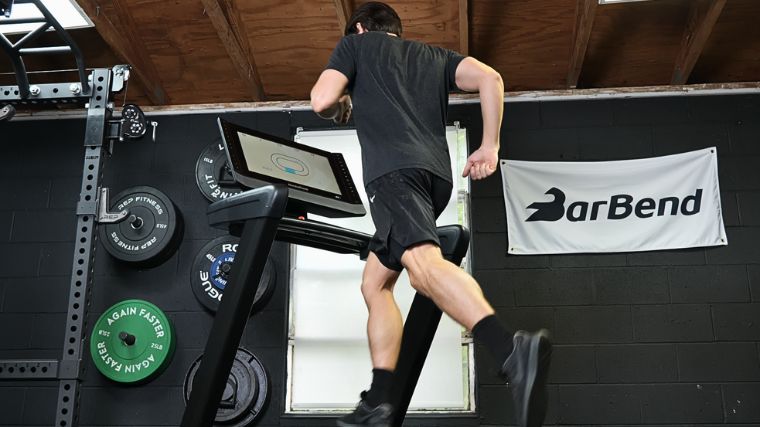
Editor’s Note: The content on BarBend is meant to be informative in nature, but it should not be taken as medical advice. When starting a new training regimen and/or diet, it is always a good idea to consult with a trusted medical professional. We are not a medical resource. The opinions and articles on this site are not intended for use as diagnosis, prevention, and/or treatment of health problems. They are not substitutes for consulting a qualified medical professional.
What Is Interval Running?
Interval running is exactly what it sounds like — bursts of speed performed in different rounds (intervals). For example, you’ll run at a challenging pace for two minutes, jog or walk for one minute, and repeat for a certain number of rounds.
During interval training, recovery periods can consist of slow jogs taken as active recovery runs, or they can include rest times that call a halt to all activity.
[Read More: HIIT Vs. LISS — Which Type of Cardio Is Better?]
As a beginner, you can use interval training to help you get faster gradually. Can’t run a full mile yet? Run it in intervals, interspersing walking with jogging until you build up your strength and stamina.
When you have more experience under your belt, you can turn up the challenge for high-intensity interval training (HIIT), performing shorter, faster speed sessions. When you’re pushing that hard, doing 20 minutes of interval training can be more than enough to improve your strength and cardio fitness.
Benefits of Interval Running
Sometimes you’ll be doing a 5-4-3-2-1 interval training session. You’ll push your limit for five minutes, recover for five minutes, push for four, recover for four, and all down to one minute.

Other times, you’ll be blazing out a quick and dirty 10-minute HIIT workout on your favorite cushioned treadmill. Here are some of the benefits you can expect.
Improved Aerobic Capacity
Across several studies, interval running has been shown to accelerate running speed and sustain endurance more reliably than steady-state cardio. (1)(2) This makes varying your running speed an ideal strategy if you want your body to hold itself together under stressful performance conditions.
Optimized Energy Production
Interval running has been shown to maximize the VO2 max of trainees beyond what is achievable through running at a steady state. (3) This means if you train using interval running, your body will be able to use greater amounts of oxygen to generate more energy.
[Read More: The 6 Benefits of HIIT to Inspire You to Go Hard]
Since you’re using more energy, interval running may also be helpful for weight loss if that’s a goal of yours. Just make sure you’re eating enough to fuel your hard training, too.
Increased Mental Toughness
Sometimes, you’ll structure interval workouts for beginners where you run or jog quickly for a few minutes, walk for a few minutes, and so on. Other times, you’ll be doing shorter, faster intervals in HIIT workouts.
[Read More: Use High-Intensity Training to Unlock New Gains]
Either way, you will develop your mentality to push yourself to your limit over and over. This will translate into a greater mental ability to crank out more reps on the platform and push yourself through even tougher workouts.
5 Interval Workouts
One of our cross-country and track and field coaches, Billy Caldwell, designed each of the following interval running workouts for our readers. Providing commentary on the workouts is ultra-distance runner and cross-country coach Lee Whitaker.
“Each of the workouts below can be useful to runners of all types aiming to get faster and improve their running,” Whitaker tells BarBend. “All of the workouts take runners through activating and training multiple energy systems — high-intensity anaerobic training and lower-intensity steady-state training.”
Lactate Threshold Interval Workout
“This workout will help to train both aerobic and anaerobic capacity through improvement in lactate threshold,” Whitaker says. “The recovery portions help the body to clear the waste products from the muscles and bloodstream, helping this process to improve over time. The faster portions of the workout also train the neuromuscular system improving efficiency and speed.”
Here’s what you’ll do.
600s, 400s, and 200s
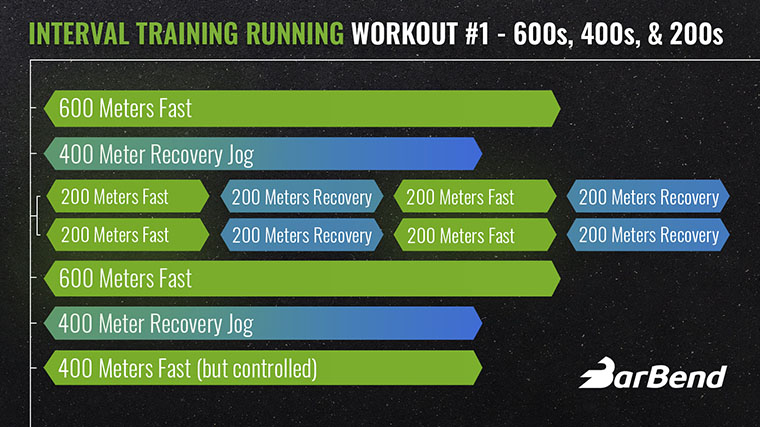
- 600 Meters: Fast
- 400 Meters: Recovery jog
- 8 x 200 Meters: Fast
- 200-Meters: Recovery jog between each 200
- 400 Meters: Recovery jog
- 600 Meters: Fast
- 400 Meters: Recovery jog
- 400 Meters: Fast, but controlled
Coach’s Tip: “Make sure the recovery portions are truly recovery and don’t take them too fast,” Whitaker advises. “Not recovering properly will leave too much waste product in the system deteriorating the effectiveness and intention of the workout.”
1,000 Meter Interval Workout
This one will also push your lactate threshold, Whitaker explains. But this time, you’ll be doing 10 intervals of a whole lot of meters — 1,000, to be precise. Your work-to-recovery ratio will be relatively small, meaning that you’ll need a lot more mental and physical stamina for this one.
1,000s and 300 cut-downs

- 10 x 1,000 Meters: Fast, but comfortable
- 200 Meters: Recovery jog after each 1,000 meters
- 5 x 300 Meters: Pick up your speed after each 100 meters, sprinting the final 100 meters of each run.
- Rest for 2 Minutes between each 300-meter interval
Coach’s Tip: “The ‘comfortable’ portion is key,” Whitaker says. “While the 1,000 meters may be challenging, it should be comfortable to maintain the same pace hopefully throughout all of them.”
4-Mile Interval Workout
You’ll run a total of four miles here. Since each mile is about 1,600 meters, you’ll run half a mile at a hard, challenging pace. The latter half of each mile, go at a more moderate pace. If you need to slow it down even further, you can — the idea is to repeat this pattern four times to add up to a four-mile interval run. Make a note of your time to compare to future efforts.
“This is a tough workout if done correctly and will also build some mental toughness for the runner,” Whitaker explains.
4 miles of alternating 800s
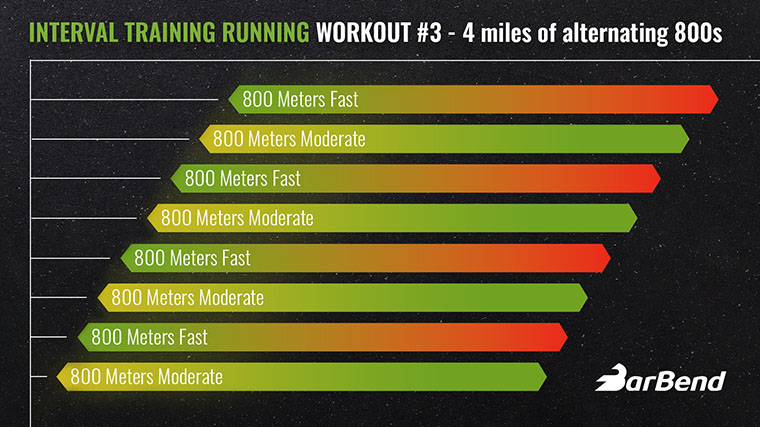
- 4 x 800 Meters
- Each segment is followed by a moderate 800-meter run
Coach’s Tip: “Focus will be key in maintaining the paces of this workout,” Whitaker explains. “Be mentally prepared.”
Long Interval Workout
You’ll be doing 1,000 meters at a time again, interspersed with four 200-meter runs at a hard effort. You’ll be challenging yourself with a very long interval and a series of relatively short intervals. This workout will feel long, mentally and physically.
1,000s and 200s
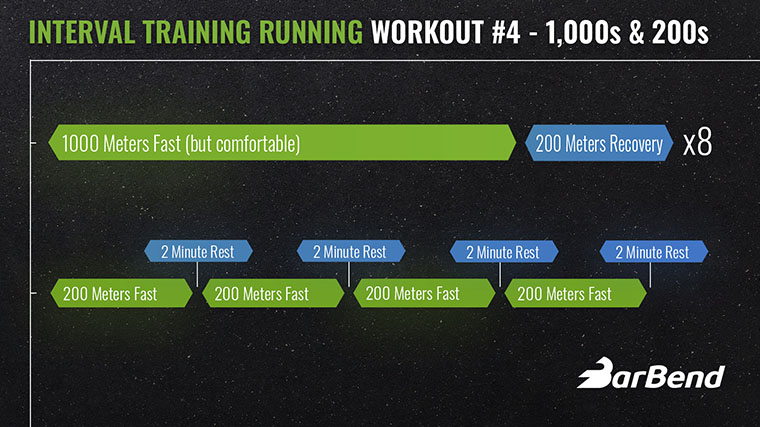
- 8 x 1,000 Meters: Fast, but comfortable
- 200 Meters: Recovery jog after each 1,000 meters
- 4 x 200 Meters: Hard
- Rest for 2 minutes between each 200-meter interval
Coach’s Tip: “Make the 200s fast and really focus on efficiency and form,” Whitaker advises.
Short Interval Workout
“This workout provides a comprehensive training stimulus in a structured progression in order to improve aerobic and anaerobic capacities, lactate threshold, running economy, and sprint mechanics,” Whitaker says.
400s and 200s
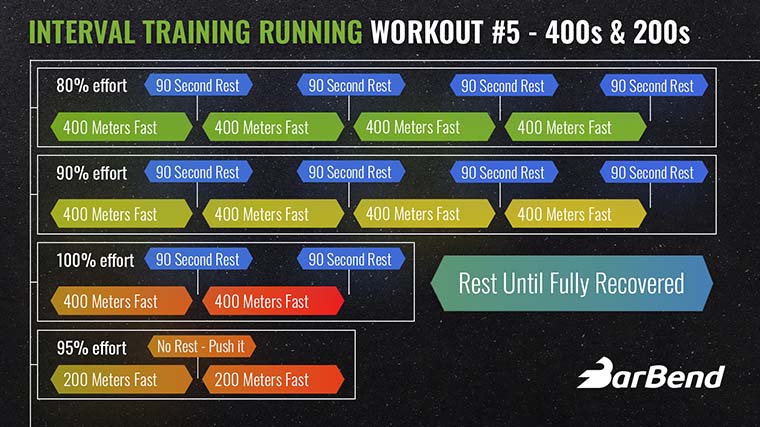
- 10 x 400 Meters: 90 seconds rest between each 400
- First 4 at 80% effort
- Second 4 at 90% effort
- Last 2 at 100% effort
- Rest until fully recovered
- 2 x 200: 90-95% effort
Coach’s Tip: “Get a good feel for the effort for each pace range and know it well,” Whitaker advises. “As in other workouts, if the pace and effort are not appropriate, the workout loses its intention and may create a runner who is out of sync with their workout plan.”
Interval Running Tips From a Running Coach
It never hurts to have an expert on hand to help you apply some fine-tuning to your plans. Here are some practical tips from an experienced running coach to help you extract the most value from your interval running strategy.
Relate Your Training to Your Distance Goal
Runners typically utilize interval runs to get fitter over specific distances. Your preparation for a half marathon may require longer intervals of lower intensity. Likewise, sprint workouts may require you to complete a higher number of intervals of a higher intensity level.
[Read More: The Best 30-Minute HIIT Workouts for a Quick Sweat Session]
“You have to ask, what is it that I’m trying to target with that interval?” advises Whitaker. “If it’s a really short, really fast interval, we’re probably working on something like lactate tolerance. When we start to talk about moving intervals to a longer repetition of 1,000 meters or even a mile, we’re going at a slower pace and training to clear our processed lactate or maybe we’re trying to raise our lactate threshold.”
Include an Adequate Rest Period
There’s a tendency to judge interval running workouts by the number of intervals included, and how many of them are work intervals at a speed that’s at or near race pace. In reality, much of the value and effectiveness of interval running stems from the quality of the recovery intervals.
“The rest and recovery period is a key part of getting interval training right,” says Whitaker. “If you’re looking for a more intense interval, you’ll have a longer rest period so that you can be recovered and fresh when you start the next one. If you’re looking for a less intense interval, you need to shorten your rest period.”
Use All of Your Energy Systems
A properly developed interval training program will put your body through the full spectrum of physiological states between your dynamic warm-up and your cool-down. You’ll want to do some slower running and some faster running to stimulate your aerobic and anaerobic energy systems. This will give you better endurance while also making you stronger and more powerful.
[Read More: Try This Dynamic Warm-Up for Running]
“When you first start, your heart rate is low and working more at an aerobic level,” explains Whitaker. “As you speed up, it moves through your lactate threshold, your critical velocity zone, your VO2 max zone, and up to some peak that might be even faster than a VO2 max.” This prepares you for a wide range of stressors that you’ll encounter on your runs and in the squat rack.
Clear the Rest of Your Schedule
While it might be tempting to slide your interval runs into the midst of your other daily training methods, that may not be the wisest choice to make. This is because coaches design interval running workouts to be extremely challenging. Packing in too much training intensity and volume may eat into your recovery and heighten your injury risk.
[Read More: The 5 Best HIIT Treadmill Workouts to Bring Some Heart to Your Training]
“Typically, we don’t put a lot of other workouts with the interval session so that we get good quality interval sessions,” warns Whitaker. “I want the quality to be high … I either do interval training as a standalone workout, or I’ll place all other work after it and keep it recovery-oriented.” That’s so you’re recovered enough to really put in a quality workout.
One Interval at a Time
Interval running isn’t all sunshine and daffodils, and it certainly isn’t an ideal training program if you prefer to have a relaxing bout of training. However, if you’re prepared to focus while you sweat, then breaking apart your running routine into intervals may be the key to preventing your body from breaking down instead.
FAQs
Interval running programs can be challenging to arrange. The answers to the questions asked below should help you put together an interval running program that can help you reach your fitness goals.
What is a good interval training workout for running?
There are several ways to structure interval running workouts to be effective. However, a comprehensive interval running workout should be physically challenging, it should require you to move at several different speeds, and it should include sufficient rest and recovery time.
The workouts above are all solid designs — they feature a hard effort of a set amount of time or meters, followed by a lower-intensity interval. Rinse and repeat.
Is it OK to do interval running every day?
While most studies exploring the benefits of interval running focus on the value of sprints, you’ll typically want to avoid doing all-out sprints in your daily training regimen. But if you’re doing lower intensity intervals and are recovering sufficiently, you may be able to handle more training frequency.
How do I plan an interval training session?
An ideal interval training session should be structured around your goals. Whereas short runs with longer recovery periods can help with power production and lactate tolerance, long runs with less recovery can help you to increase your lactate threshold.
What are the benefits of interval training for runners?
Runners can use interval training to increase cardiovascular endurance, improve the body’s ability to tolerate lactic acid, and boost energy efficiency.
References
- Wisløff U, Støylen A, Loennechen JP, Bruvold M, Rognmo Ø, Haram PM, Tjønna AE, Helgerud J, Slørdahl SA, Lee SJ, Videm V, Bye A, Smith GL, Najjar SM, Ellingsen Ø, Skjaerpe T. Superior cardiovascular effect of aerobic interval training versus moderate continuous training in heart failure patients: a randomized study. Circulation. 2007 Jun 19;115(24):3086-94.
- Kavanagh T, Shephard RJ. Conditioning of postcoronary patients: comparison of continuous and interval training. Arch Phys Med Rehabil. 1975 Feb;56(2):72-6.
- Helgerud J, Høydal K, Wang E, Karlsen T, Berg P, Bjerkaas M, Simonsen T, Helgesen C, Hjorth N, Bach R, Hoff J. Aerobic high-intensity intervals improve VO2max more than moderate training. Med Sci Sports Exerc. 2007 Apr;39(4):665-71.